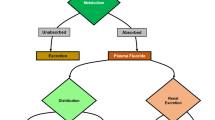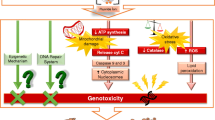Abstract
Because sodium fluoride (NaF) is widely used for prevention of dental caries, pathobiological effects of NaF were investigated on human oral mucosal fibroblasts. The results showed that NaF was cytotoxic to oral mucosal fibroblasts at concentrations of 4 mmol/L or higher. Exposure of cells to NaF for 2 h also inhibited protein synthesis, cellular ATP level and functional mitochondrial activities in a dose-dependent manner. However, incubation of cells with NaF up to 12 mmol/L for 2 h depleted only 13% of cellular glutathione level. The IC50 of NaF on cellular ATP level was about 5.75 mmol/L. Preincubation of the cells with pyruvate and succinate did not protect cells from NaF-induced ATP depletion. At concentrations of 4 mmol/L, 8 mmol/L and 12 mmol/L, NaF inhibited 31%, 56% and 57% of mitochondrial functions, respectively, after 2 h incubation. No significant inhibition for NaF was found at concentrations lower than 2 mmol/L (40 ppm). These results indicate that NaF can be toxic to oral mucosal fibroblasts in vitro by its inhibition of protein synthesis, mitochondrial function and depletion of cellular ATP. Because of repeated and long-term usage of NaF, more detailed studies should be undertaken to understand its toxic effects in vitro and in vivo.
Similar content being viewed by others
References
Albanese R. Sodium fluoride and chromosome damage (in vitro human lymphocyte and in vivo micronucleus assays). Mutagenesis. 1987;2:497–9.
Cimasoni G. The inhibition of enolase by fluoride in vitro. Caries Res. 1972;6:93–102.
Duckworth RM, Morgan SN. Oral fluoride retention after use of fluoride dentifrices. Caries Res. 1991;25:123–9.
Gabler WL. Absorption of fluoride through the oral mucosa of rats. Arch Oral Biol. 1968;13:619–23.
Harold DE, Walz W. Metabolic inhibition and electrical properties of type-1-like cortical astrocytes. Neuroscience. 1992; 47: 203–11.
Hata Y, Watanabe M, Tonada K, Hirata M. Aziridine biotransformation by microsomes and lethality to hepatocytes isolated from rat. Chem-Biol Interact. 1987;63:171–84.
Hegeland K, Leirskar J. pH and the cytotoxicity of fluoride in an animal cell culture system. Scand J Dent Res. 1976;84: 37–45.
Holland RI. Cytotoxicity of fluoride. Acta Odontol Scand. 1980;8:69–79.
Holland RI, Hongslo JK. Fluoride and energy metabolism in LS cells. Acta Pharmacol Toxicol. 1979;44:347–9.
Hsieh CC, Guo MK, Hong YC, Chen RS. An evaluation of caries prevalence in Chung-Shin New Village after 12 years of water fluoridation. J Formos Med Assoc. 1986;85:822–31.
Jacobson APM, Strang R, Stephen KW. Mixed salivary and buccal mucosal fluoride levels with Non-F and 1500 ppm F dentifrices. Caries Res. 1992a;26:222–3.
Jacobson APM, Stephen KW, Strang R. Fluoride uptake and clearance from the buccal mucosa following mouthrinsing. Caries Res. 1992b;26:56–8.
Jeng JH, Kuo ML, Hahn LJ, Kuo MYP. Genotoxic and non-genotoxic effects of betel quid ingredients on oral mucosal fibroblasts in vitro. J Dent Res. 1994a;73:1043–9.
Jeng JH, Hahn LJ, Lu FJ, Wang YJ, Kuo MYP. Eugenol triggers different pathobiological effects upon oral mucosal fibroblasts. J Dent Res. 1994b;73:1050–5.
Kosower NS, Kosower EM. The glutathione status of cells. Int Rev Cytol. 1978;54:109–59.
Leverett DH. Fluorides and changing prevalence of dental caries. Science. 1982;217:26–30.
Matsui Y, Kitade H, Kamiya T et al. Adenylate energy charge of rat and human cultured hepatocytes. In Vitro Cell Dev Biol Animal. 1994;30A:609–14.
Mosmann T. Rapid colorimetric assay for cellular growth and survival: application to proliferation and cytotoxicity assay. J Immunol Methods. 1983;65:55–63.
Oguro A, Koizumi N, Hori K. Effect of fluoride ion on proliferation of vero cell line cells: growth acceleration by sodium fluoride. J Dent Health. 1982;31:453–60.
Oguro A, Cevenka K, Hori K. Effect of sodium fluoride on growth of human diploid cells in culture. Pharmacol Toxicol. 1990;67:411–14.
Poole B, Wibo M. Protein degradation in cultured cells: the effect of fresh medium, fluoride and iodoacetate on the digestion of cellular protein of rat fibroblasts. J Biol Chem. 1973;218:6221–6.
Primosch RE, Weatherell JA, Strong M. Distribution and retention of salivary fluoride tablet following various intra-oral dissolution methods. J Dent Res. 1986;65:1001–5.
Redegeld FAM, Moison RMW, Barentsen AS, Koster AS, Noordhoel K. Interaction with cellular ATP generating pathways mediates menadione-induced cytotoxicity in isolated rat hepatocytes. Arch Biochem Biophys. 1990;280: 130–6.
Richmond VL. Thirty years of fluoridation: a review. Am J Clin Nutr. 1985;41:129–38.
Sato T, Yagori A, Niwa M. Low sensitivity of cultured human young adult and adult gingival fibroblasts to fluoride. I. Relation of doubling time. Pharmacol Toxicol. 1987;61: 313–5.
Singer L, Ophaug R. Ionic and nonionic fluoride in plasma (or serum). CRC Crit Rev Clin Lab Sci. 1982;18:111–40.
Spragg RG, Hinshaw DB, Hyslop PA, Schraufstatter IU, Cochrane CG. Alterations in adenosine triphosphate and energy charge in cultured endothelial and P388D1 cells after oxidant injury. J Clin Invest. 1985;76:1471–6.
Thomson EJ, Kilanowski FM, Perry PE. The effect of fluoride on chromosome aberration and sister-chromatid exchange frequencies in cultured human lymphocytes. Mutat Res. 1985;144:89–92.
Tsutsui T, Suzuki N, Ohmori M, Maizumi H. Cytotoxicity, chromosome aberrations and unscheduled DNA synthesis in cultured human diploid fibroblasts induced by sodium fluoride. Mutat Res. 1984a;139:193–8.
Tsutsui T, Ide K, Maizumi H. Induction of unscheduled DNA synthesis in cultured human oral keratinocytes by sodium fluoride. Mutat Res. 1984b;140:43–8.
Vogel GL, Mao Y, Carey CM, Chow LC. Increased overnight fluoride concentrations in saliva, plaque and plaque fluid after novel two-solution rinse. J Dent Res 1997;76:761–7.
Voroschilin SI, Plotko EG, Gatiyatullina EZ, Gileva EA. Cytogenetic effect of inorganic fluorine compounds on human and animal cells in vivo and in vitro. Sov Genet. 1973; 9: 492–6.
Whitford GM. Intake and metabolism of fluoride. Adv Dent Res. 1994;8:5–14.
Author information
Authors and Affiliations
Rights and permissions
About this article
Cite this article
Jeng, J., Hsieh, C., Lan, W. et al. Cytotoxicity of sodium fluoride on human oral mucosal fibroblasts and its mechanisms. Cell Biol Toxicol 14, 383–389 (1998). https://doi.org/10.1023/A:1007591426267
Issue Date:
DOI: https://doi.org/10.1023/A:1007591426267




